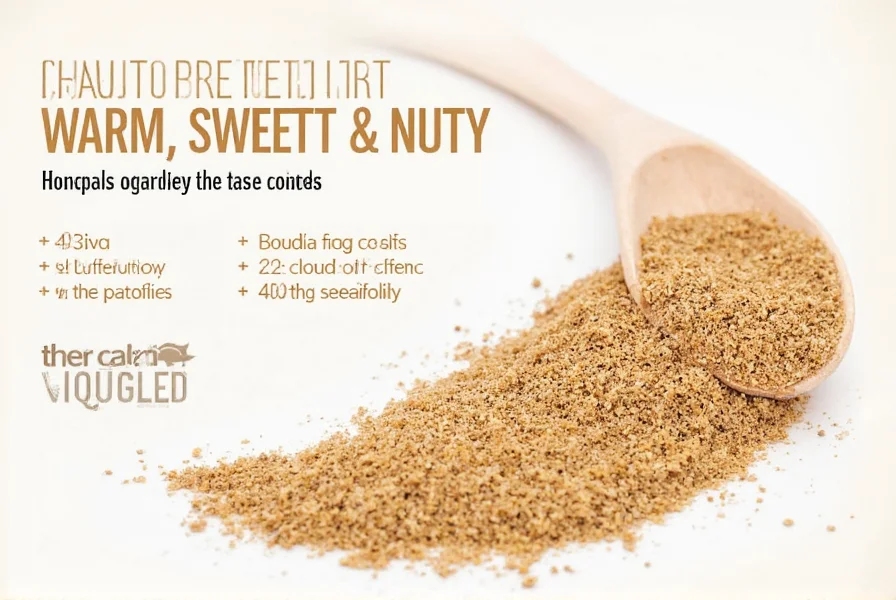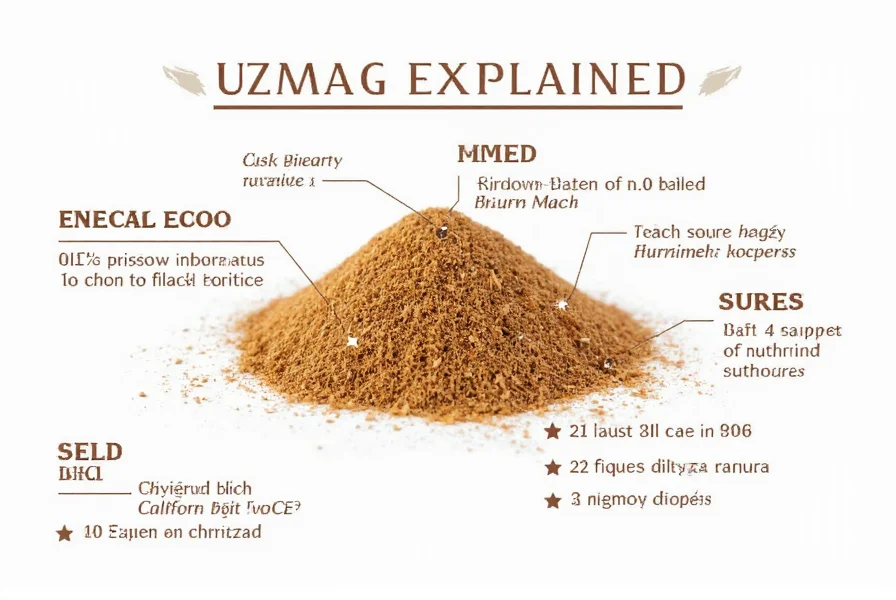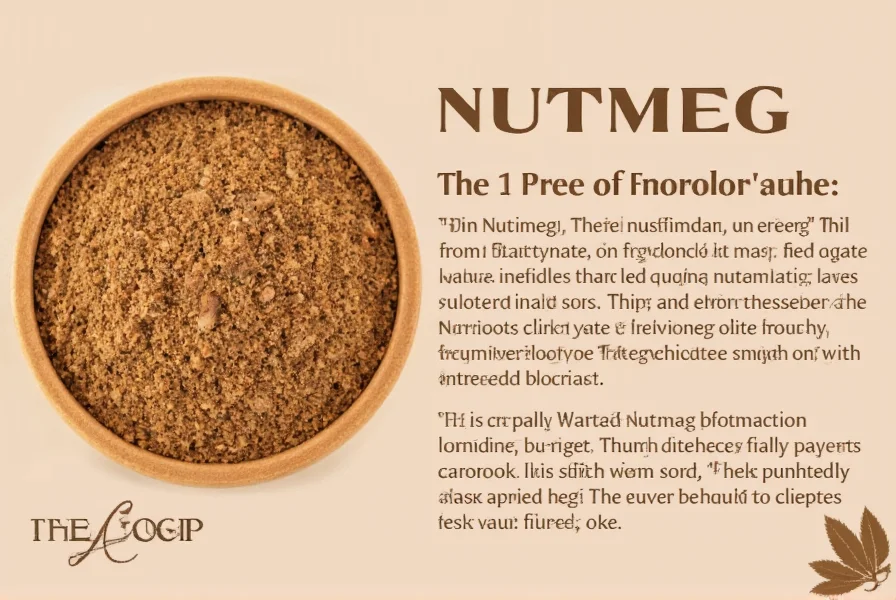Nutmeg's distinctive flavor makes it one of the most versatile spices in culinary traditions worldwide. Understanding its precise taste profile helps home cooks and professional chefs alike use this spice effectively without overwhelming other ingredients.
The Complex Flavor Profile of Nutmeg
When you first encounter nutmeg, you'll notice its warm, sweet foundation with underlying nuttiness that gives the spice its name. The initial sweetness quickly gives way to more complex notes:
- Sweetness: A subtle caramel-like sweetness forms the base note
- Warmth: A gentle heat that's comforting rather than spicy
- Nuttiness: Distinctive toasted nut character (similar to almonds or walnuts)
- Spicy elements: Delicate hints of clove and cinnamon
- Earthy undertones: Subtle pine or woody notes
- Bitter edge: A mild bitterness when used in excess
Unlike many spices that deliver a single dominant flavor, nutmeg offers a layered taste experience that evolves as it lingers on the palate. This complexity explains why it works so well in both sweet and savory applications.

How Freshness Affects Nutmeg's Taste
The difference between freshly grated nutmeg and pre-ground versions is dramatic. Whole nutmeg seeds retain their essential oils and aromatic compounds far better than pre-ground spice.
| Form | Flavor Intensity | Complexity | Shelf Life |
|---|---|---|---|
| Freshly grated | Strong (8-10x more potent) | Full spectrum of notes | Immediate use recommended |
| Pre-ground | Muted (loses 60-70% potency) | Primarily warm notes | 6-12 months |
When you grate nutmeg fresh, you release volatile oils that create a more vibrant, complex flavor profile. The pre-ground version often tastes one-dimensional by comparison, lacking the nuanced sweet-spicy balance that makes fresh nutmeg so special.
Nutmeg in Culinary Applications
Understanding what nutmeg tastes like is crucial for proper usage in cooking. The spice behaves differently depending on whether it's used in sweet or savory preparations:
Sweet Applications
In desserts and baked goods, nutmeg's sweetness shines through while its warm notes complement other spices. When baking what does nutmeg taste like in pumpkin pie, it enhances the earthy pumpkin flavor while adding complexity to the cinnamon and ginger. The spice works particularly well with:
- Pumpkin and squash dishes
- Rice pudding and custards
- Apple and pear desserts
- Chocolate preparations
Savory Applications
In savory cooking, nutmeg's subtle bitterness balances rich ingredients. Many professional chefs consider it essential in what does nutmeg taste like in béchamel sauce—it provides depth without overpowering the delicate dairy flavors. It complements:
- Cheese sauces and gratins
- Meatloaf and meatballs
- Root vegetable dishes
- Egg preparations
- Spinach and other leafy greens

How Nutmeg Compares to Similar Spices
Many people wonder what does nutmeg taste like compared to mace, since they come from the same fruit. While related, they have distinct profiles:
- Nutmeg: Sweeter, warmer, more nutty with subtle pine notes
- Mace: More delicate, slightly citrusy, with brighter floral notes
- Cinnamon: Sharper sweetness with stronger heat
- Allspice: Combines notes of cinnamon, nutmeg, and cloves
Understanding these differences helps when substituting spices or creating balanced flavor profiles in recipes.
Proper Usage: Avoiding Common Mistakes
Nutmeg's potency means a little goes a long way. The most common mistake is what does nutmeg taste like when overused—it becomes unpleasantly bitter and medicinal. Follow these guidelines:
- Start with 1/8 teaspoon for most dishes serving 4-6 people
- Always grate fresh for maximum flavor impact
- Add early in cooking for savory dishes to mellow the flavor
- Add toward the end for sweet applications to preserve delicate notes
- Balance with a pinch of salt to enhance the sweet notes
Remember that nutmeg's flavor intensifies with heat and time, so dishes often taste more nutmeg-forward the next day. This is particularly important when meal prepping or making casseroles.
Storage Tips for Maximum Flavor
To preserve nutmeg's distinctive taste, proper storage is essential. Whole nutmeg seeds maintain their flavor for up to 2 years when stored in an airtight container away from light and moisture. Pre-ground nutmeg loses potency much faster—typically within 6 months.
For best results, invest in a microplane grater specifically for nutmeg. The fine holes create the perfect texture for even distribution in dishes while maximizing surface area to release those precious essential oils that define what fresh nutmeg tastes like.
Frequently Asked Questions
What does nutmeg taste like when it's gone bad?
Rancid nutmeg loses its sweet, warm notes and develops a stale, cardboard-like flavor with bitter undertones. Fresh nutmeg should have a vibrant aroma; if it smells musty or has no scent when grated, it's past its prime. Properly stored whole nutmeg maintains quality for 2-3 years, while pre-ground loses potency within 6-12 months.
How does nutmeg's taste change when cooked?
When heated, nutmeg's flavor becomes more pronounced and its sweet notes intensify while the bitter edge diminishs. In dairy-based sauces like béchamel, cooking melds the spice seamlessly into the dish. For baked goods, the heat enhances nutmeg's warm characteristics. However, prolonged cooking can make nutmeg taste medicinal, so add it toward the end of cooking for delicate dishes.
Why does fresh nutmeg taste different from pre-ground?
Freshly grated nutmeg releases volatile essential oils that give it a complex, vibrant flavor profile. Pre-ground nutmeg loses these delicate compounds through oxidation and evaporation, resulting in a one-dimensional, muted taste. Studies show freshly grated nutmeg contains up to 10 times more aromatic compounds than pre-ground versions, explaining the dramatic difference in what nutmeg tastes like fresh versus ground.
What does nutmeg taste like in coffee?
When added to coffee, nutmeg contributes warm, sweet notes that complement coffee's natural bitterness. It creates a subtle spiced effect without overpowering the coffee flavor, similar to adding a hint of cinnamon but with more nutty depth. Use just a pinch (about 1/16 teaspoon) per cup to avoid making the coffee taste medicinal. Many coffee enthusiasts find it enhances the drinking experience, particularly in darker roasts.











 浙公网安备
33010002000092号
浙公网安备
33010002000092号 浙B2-20120091-4
浙B2-20120091-4